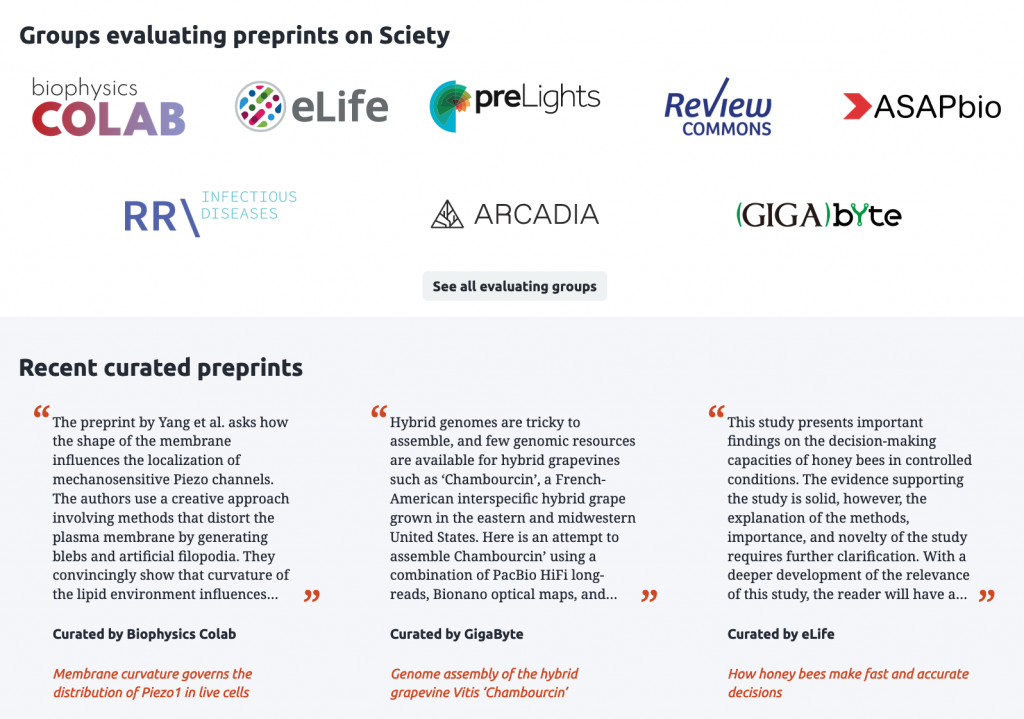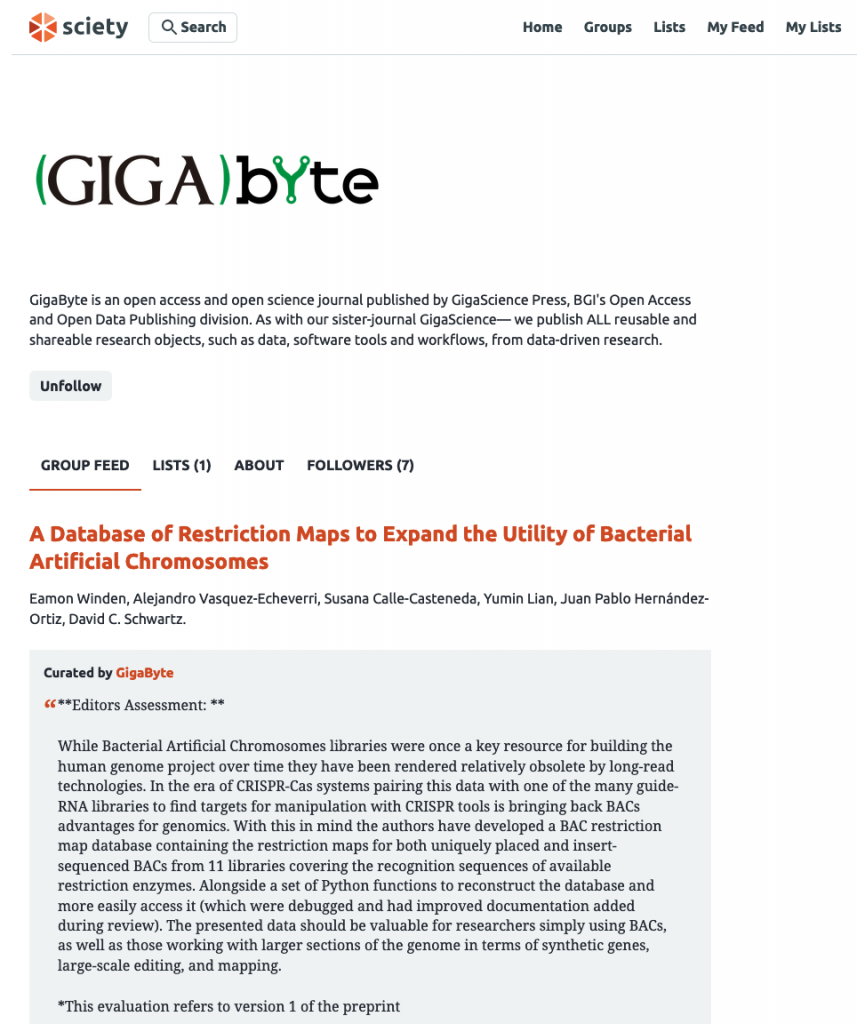Peer Review Week 2023: GigaByte joins the ‘Publish, Review, Curate’ Revolution using Sciety
Timed for Peer Review Week 2023, we’d like to announce that GigaByte Journal has integrated a novel ‘Publish, Review, Curate’ (PRC) peer-review model, in partnership with eLife. Using eLife’s Sciety platform GigaByte is now offering a highlighted editor’s assessment of each reviewed preprint, this endorsement helps readers gauge the interest and importance of the work, while also throwing light on the review and assessment process of research.

GigaByte has made our principle goal to match the speed of publishing to the speed of research. When we launched in September 2020, our strict Open Science policy meant we were one of the first journals to mandate the use of preprints, to help increase transparency and speed up the dissemination of research. As our journals have also mandated Open Peer Review, GigaByte has been able to connected our articles to previously published preprint versions by crosslinking and highlighting these links via an Article Information section on their articles. With the rise of preprint peer review and evaluation policies, the logical next step was to utilise bioRxiv and Sciety integrations that enable the sharing of these open peer reviews on any associated preprint. We also have been sharing these preprint peer reviews (AKA “evaluations”) in Sciety ‘Reviewing Groups’ to enable further discoverability and insight for readers.
In a new step, GigaByte is now building on this “publish then review” model of scientific communication by adding an endorsement step and aligning it with eLife’s new ‘publish, review, curate’ model that puts preprints first. This is done using the new ‘Curating Groups’ feature from Sciety, to distinguish groups that offer some form of assessment/endorsement of a preprint. These Endorsement statements from GigaByte featured on this page are also highlighted on the original bioRxiv preprint as well as the associated Sciety article page. Altogether, this helps readers see at a glance why this preprint might be important or interesting.

In January 2023, eLife became the first journal to embrace a new scientific publishing model, where every preprint that eLife sends for peer review will be published on their website as a “Reviewed Preprint” together with an assessment, public reviews, and a response from the authors. GigaByte is taking a step towards this ‘Publish, Review, Curate’ (PRC) peer-review model, being the second journal after eLife to post these Editorial endorsements in Sciety ‘Curating groups’, alongside other evaluating communities such as Biophysics Colab.
GigaByte Chief Editor Scott Edmunds comments on this move, saying “We’d like to thank Sciety for helping us take this step towards meeting our goal of matching the speed of publishing to the speed of research through using their platform”.
Kaveh Bazargan from our publishing partner River Valley Technologies notes that:
“River Valley’s systems have been built to support the aims as well as the spirit of Open Science. This includes alignment with the UNESCO Open Science Recommendation which specifically promotes innovative approaches such as preprints and open peer review practices, as used here. Our peer review system, ReView, together with our XML-first end-to-end publishing system enables publishing within 24 hours of acceptance. River Valley platforms allow GigaByte to provide fully open data, accessibility and transparency, revealing the pre-publication and open peer review history. It is a pleasure to work with GigaScience Press with whom we continually push the boundaries.”
Shane Alsop, Community Manager – Outreach, eLife, on behalf of the Sciety Team adds to this:
“We’re delighted to be partnering with GigaByte to help facilitate their move towards a ‘publish first, then review’ model of preprint peer-review. GigaByte are now providing an ‘editors assessment’ statement to accompany each reviewed preprint displayed on Sciety. For the first time, these statements will allow multiple communities to strengthen/scrutinise the findings reported in a preprint through cumulative, post-publication review. This approach not only prioritises the importance of research integrity over publication venue, but combines with more traditional outputs of preprint review to make evaluated preprints a first class research object in their own right.
Organisations as diverse as Biophysics CoLab and eLife successfully leverage Sciety to experiment with variations of the ‘PRC’ model, and GigaByte’s own transition signifies a pivotal step towards wider adoption of ‘PRC’. With GigaByte’s support, we look forward to collaborating with more journals to catalyse wider adoption of more transparent – and equitable – modes of peer review.”
As Open Science advocates this is just an incremental move for the journal, but we anticipate taking future steps to support a preprint-based publishing system. As the theme of Peer Review Week 2023 this week is “Peer Review and The Future of Publishing” this is a very timely and practical demonstration of exactly what the future can look like. So far this integration only works for the roughly 2/3 of preprints that we link to that utilise bioRxiv and medRxiv, although we hope this expands to all of the other preprint servers our authors are using. Particularly the regional and language specific preprint servers our some of our authors have been using like SciELO preprints, AfricaArxiv, and ChinaXiv. You can see a video from Peer Review Week 2021 where we were making our initial moves down this route, with the announcement that we were just starting to integrate our open peer reviews with bioRxiv. So this year we are please to give an update on how these efforts are progressing.
Follow and read GigaByte’s curated content on Sciety here: https://sciety.org/groups/gigabyte/
Further Reading
Edmunds SC, Goodman L. GigaByte: Publishing at the Speed of Research. GigaByte. 2020 Jul 1; 2020:gigabyte1. doi: 10.46471/gigabyte.1
Edmunds SC. Peering into peer-review at GigaScience. Gigascience. 2013 Jan 24;2(1):1. doi:10.1186/2047-217X-2-1